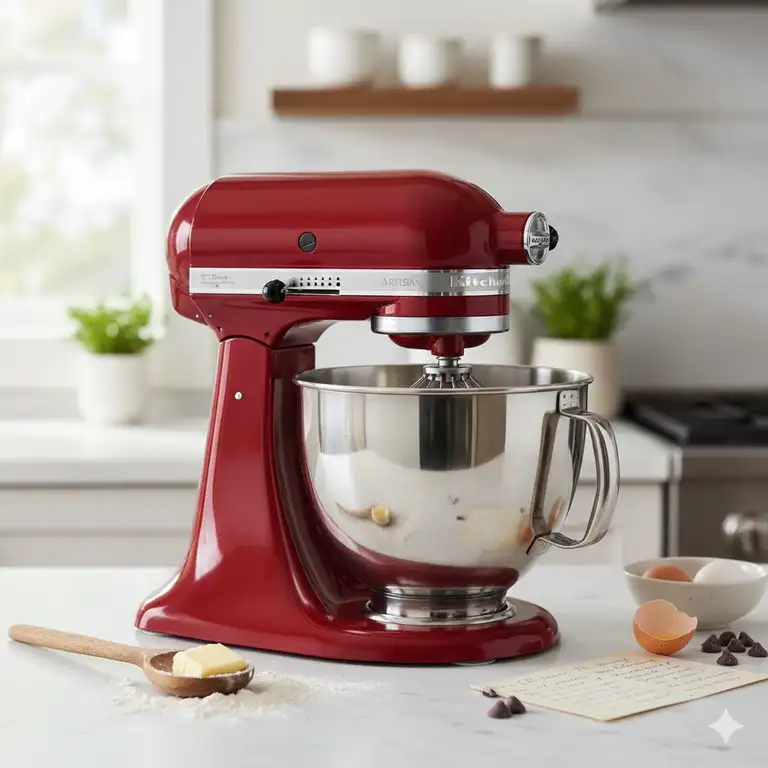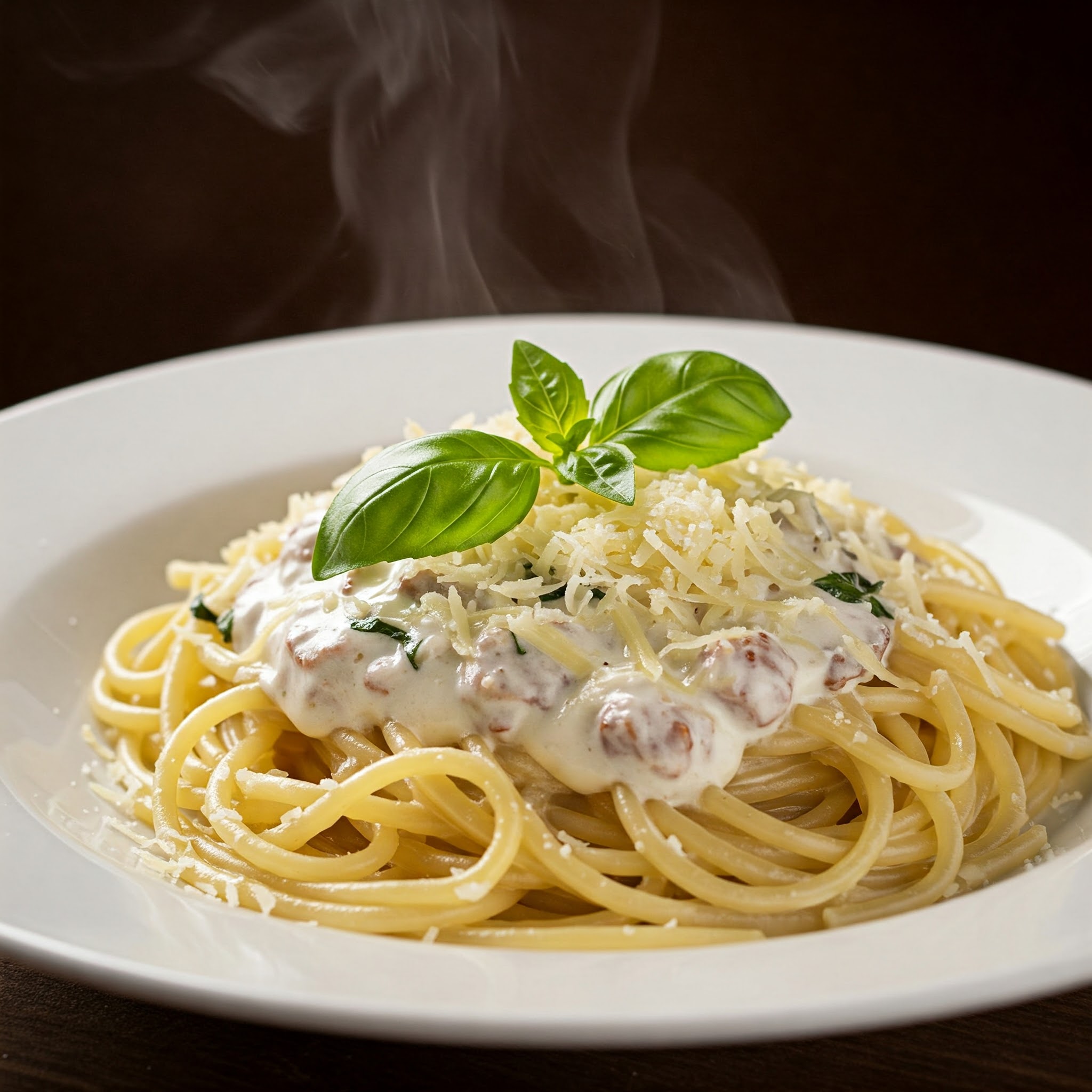Kerala kitchen traditions bring the vibrant flavors of South India right to your home. This comprehensive guide explores everything you need to know about creating authentic Kerala cuisine, from essential ingredients to cooking techniques.
✨Was this helpful? Spread the word! 🚀
Kerala Kitchen: A Culinary Paradise
The Kerala kitchen represents one of India’s most diverse and flavorful culinary traditions. Often called “God’s Own Country,” Kerala’s unique geography—sandwiched between the Arabian Sea and the Western Ghats—has blessed this southern Indian state with an abundance of spices, seafood, and tropical produce that defines its distinctive cuisine.
When you step into a traditional Kerala kitchen, you’re entering a world where recipes have been perfected over centuries, passed down through generations with careful attention to balancing flavors, textures, and nutritional benefits. The cuisine’s hallmarks include the liberal use of coconut, fragrant curry leaves, mustard seeds, and an array of spices that create complex, layered flavors without overwhelming heat.
What makes Kerala kitchen techniques particularly special is their ability to transform simple ingredients into extraordinary dishes. From the humble coconut to the prized black pepper (once worth its weight in gold), Kerala cooks know exactly how to coax out maximum flavor using traditional methods that have stood the test of time.
For Americans looking to explore beyond the familiar terrain of North Indian restaurant fare, Kerala cuisine offers a refreshing alternative—lighter, often healthier, and incredibly diverse. Whether you’re a seasoned cook or just beginning your journey into Indian cooking, the Kerala kitchen provides accessible yet authentic ways to bring South Indian flavors into your home.
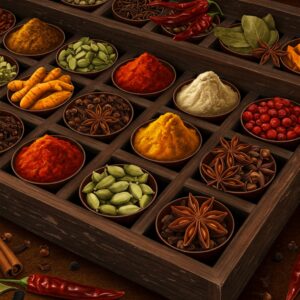
The Historical Significance of Kerala Kitchen
The story of the Kerala kitchen begins thousands of years ago when this coastal region became central to the spice trade that connected East and West. As early as 3000 BCE, Kerala’s black pepper, cardamom, cinnamon, and other spices were being exported to Mesopotamia, Egypt, and beyond.
This strategic position in global trade routes exposed Kerala to numerous culinary influences—Arab, Portuguese, Dutch, French, and British traders all left their mark on the local cooking traditions. Yet remarkably, Kerala cuisine maintained its distinctive character while selectively adopting compatible elements from these visiting cultures.
Traditional Kerala kitchens were designed with specific areas for different cooking processes. The central hearth (aduppu) usually comprised three stones arranged to support cooking vessels over an open fire. More affluent homes might have multiple cooking stations for different types of dishes. The layout of the Kerala kitchen reflected both practical considerations and ritual significance, with specific spaces for grinding spices, fermenting batters, and preparing ceremonial foods.
According to culinary historian K.T. Achaya, Kerala’s cooking techniques demonstrate sophisticated understanding of flavor extraction and preservation methods that were ahead of their time .
Essential Equipment for Your Kerala Kitchen
Creating authentic Kerala dishes requires some specialized equipment that might not be found in typical American kitchens. Here are the essential tools you’ll need:
1. Traditional Cookware
The cornerstone of any Kerala kitchen is the Manchatti (clay pot). This traditional earthenware cooking vessel imparts a distinctive earthy flavor to curries and stews that simply can’t be replicated in metal pots. The Manchatti allows slow, even heat distribution and creates the authentic taste profile that defines Kerala cooking.
For those serious about authentic Kerala cooking, investing in the Uruli (a wide, shallow vessel traditionally made of bell metal) provides the perfect surface for making thorans (vegetable stir-fries) and preparing festival sweets. Its broad surface area allows for quick evaporation and concentration of flavors.
2. Grinding Tools
No Kerala kitchen is complete without a Ammikallu (traditional grinding stone). While modern blenders can substitute in a pinch, the granite grinding stone produces superior texture in coconut chutneys and masala pastes—the cornerstone of Kerala cooking. The stone-ground pastes release oils and aromas differently than machine-processed mixtures.
If counter space is limited, the Aattukallu (hand-held grinding stone) offers a smaller alternative that still delivers authentic results for smaller quantities of spices and herbs.
3. Specialized Utensils
The Chiratta Karandi (coconut shell ladle) is not just decorative but functional—perfect for stirring coconut milk-based curries without scraping delicate clay pots. Meanwhile, the Ottu Karandi (metal spatula with a long handle) keeps hands safe from spluttering mustard seeds during tempering processes.
4. Modern Adaptations
For today’s busy home cooks, an Instant Pot can be a game-changer for Kerala recipes that traditionally require long simmering times. With proper adjustments, pressure cooking can deliver authentic flavors in a fraction of the time, making weeknight Kerala meals feasible for American households.
A quality spice grinder is another modern essential, allowing you to work with whole spices (crucial for authentic flavor) and grind them fresh as needed. This maintains the volatile oils that preground spices lose quickly after processing.

Essential Ingredients in Kerala Kitchen
The soul of Kerala cuisine lies in its distinctive ingredients. Here’s what you’ll need to stock your pantry:
1. The Coconut Trinity
Coconut appears in multiple forms in Kerala kitchen preparations:
- Fresh coconut: The foundation of countless dishes, grated coconut provides texture and subtle sweetness
- Coconut milk: Extracted in two or three pressings of different concentrations for various applications
- Coconut oil: The traditional cooking medium that gives Kerala dishes their authentic character
For American kitchens, frozen grated coconut is a practical alternative to fresh, while canned coconut milk (preferably without additives) works well for most recipes.
2. The Spice Foundation
Kerala’s spice combinations are distinctive and essential to authentic flavor:
- Black pepper: Kerala’s “black gold,” providing heat without overwhelming other flavors
- Cardamom: The queen of spices, offering floral and citrus notes
- Cinnamon: Used in both sweet and savory preparations
- Cloves: Providing intense aromatic qualities
- Turmeric: Essential for color and health benefits
- Dried red chilies: For controlled heat
The renowned Kerala Garam Masala differs significantly from its North Indian counterpart, with a higher proportion of cardamom, cloves, and cinnamon, reflecting the region’s historic position as the heart of the spice trade. According to research from the Indian Institute of Spices Research, Kerala’s unique climate conditions produce spices with distinctive flavor compounds not found elsewhere .
3. Fresh Aromatics
No Kerala kitchen functions without these fresh ingredients:
- Curry leaves: The signature aroma of South Indian cooking
- Green chilies: Fresh heat and brightness
- Ginger: Used abundantly in pastes and marinades
- Garlic: Often paired with ginger in base preparations
- Shallots: Preferred over regular onions for their sweeter flavor profile
4. Souring Agents
Kerala cuisine masterfully balances flavors, with sourness playing a crucial role:
- Kodampuli (Garcinia cambogia): A distinctive dried fruit used in fish curries
- Tamarind: For tangy gravies and chutneys
- Raw mango: Both for freshness and preserving traditions
- Kokum: A subtle souring agent used in seafood preparations
5. Specialty Items
These less common ingredients deliver authentic Kerala flavors:
- Matta rice: The red parboiled rice traditional to Kerala
- Banana leaves: Used for cooking and serving
- Coconut vinegar: For pickling and marinades
- Jaggery: Unrefined cane sugar used in desserts and to balance flavors in savory dishes
Signature Cooking Techniques in Kerala Kitchen
The magic of Kerala cuisine comes as much from its cooking techniques as its ingredients:
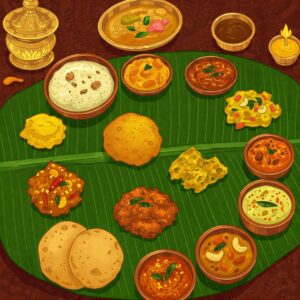
1. Tempering (Tadka)
This fundamental technique involves heating whole spices in coconut oil to release their essential oils before adding other ingredients. The distinctive crackle of mustard seeds is the soundtrack of Kerala kitchens!
Common tempering ingredients include:
- Mustard seeds
- Dry red chilies
- Curry leaves
- Fenugreek seeds
- Asafoetida
2. Slow Cooking in Earthenware
Traditional dishes like Meen Curry (fish curry) develop their characteristic depth from slow simmering in clay pots. The porous nature of the clay allows subtle heat transfer and moisture exchange that metal pots cannot replicate.
3. Grinding on Stone
The texture achieved from stone-ground masalas is distinctly different from electric grinders. The friction of stone on stone releases oils and combines ingredients in ways that impact the final flavor profile significantly.
4. Steaming in Banana Leaves
Dishes like Karimeen Pollichathu (pearl spot fish) and Ela Ada (sweet rice dumplings) are wrapped in banana leaves before cooking, which imparts subtle flavor while sealing in moisture and nutrients.
5. Fermentation
Techniques for fermenting rice and lentil batters have been perfected over generations in Kerala kitchens. The science behind these processes has been studied by food researchers at the Central Food Technological Research Institute, confirming the nutritional benefits of these traditional practices .
Regional Variations in Kerala Kitchen
Kerala cuisine isn’t monolithic—distinct regional variations exist within this small state:
Northern Kerala (Malabar)
The Muslim influence is strong here, with rich, meat-heavy preparations like:
- Thalassery Biryani: Uniquely made with short-grain kaima rice instead of basmati
- Kozhikode Halwa: A dense, sweet confection in vibrant colors
- Pathiri: Thin rice flour breads served with spicy curries
Central Kerala (Kochi Region)
With strong Christian influences, this region is known for:
- Duck Roast: Slow-cooked with robust spices
- Appam with Stew: Lacy rice hoppers with coconut milk stew
- Meen Molee: Fish in creamy coconut sauce with subtle spicing
Southern Kerala (Travancore)
Predominantly Hindu vegetarian traditions shine here:
- Sadya: The elaborate vegetarian feast served on banana leaves
- Avial: Mixed vegetables in yogurt-coconut sauce
- Pulissery: Yogurt-based curry with cucumbers or mangoes
Modern Kerala Kitchen Adaptations for American Homes
Bringing Kerala kitchen traditions to American homes requires some practical adaptations:
Ingredient Substitutions
- When fresh curry leaves aren’t available, dried ones can substitute (though with less vibrancy)
- Regular yellow onions can replace shallots (though the flavor will be sharper)
- Regular whole milk yogurt can substitute for homemade curd in many recipes
Time-Saving Techniques
- Pressure cookers or Instant Pots dramatically reduce cooking times for Kerala stews and curries
- Pre-made spice blends from reliable sources can save time without significantly compromising flavor
- Batch preparation of basic masala pastes that can be frozen in small portions
According to a study published in the Journal of Ethnic Foods, traditional cooking methods significantly impact the health benefits of spices through the release of bioactive compounds .
Essential Kerala Kitchen Products for Your Home
Creating an authentic Kerala kitchen experience requires some specialized tools and ingredients. Here are some top recommendations:

1. Cooking Equipment
The CLAY CURRY POT Traditional Indian Cooking Vessel brings authentic earthenware cooking to your home. This handcrafted clay pot is perfect for making traditional Kerala fish curry and vegetable preparations that benefit from slow, even heat distribution. The porous clay imparts a subtle earthy flavor that elevates your dishes to restaurant quality. Clay Curry Pot is an investment in authentic cooking that will last for years with proper care.
For quick preparation of Kerala staples, the Instant Pot Duo 7-in-1 serves as an excellent modern alternative to traditional pressure cookers. Its preset functions make it easy to prepare Kerala rice varieties, lentil dishes, and even some curries with consistent results.
2. Spice Essentials
The Keralite Premium Spice Collection brings together all the essential spices needed for authentic Kerala cooking. This comprehensive set includes cardamom, cloves, cinnamon, black pepper, and specialized blends like Kerala garam masala. The Keralite Premium Spice Collection is ethically sourced directly from Kerala farms, ensuring maximum freshness and authentic flavor profiles.
For grinding fresh spices, the SHARDOR Electric Spice Grinder provides efficient processing while preserving the volatile oils critical to authentic flavor. Its stainless steel blades make quick work of whole spices for fresh masalas.
3. Specialty Ingredients
Pure Indian Foods Organic Virgin Coconut Oil delivers the authentic base for Kerala cooking. Cold-pressed and unrefined, this oil provides the distinctive flavor foundation that defines Kerala cuisine. Pure Indian Foods Organic Virgin Coconut Oil is versatile enough for cooking, skin care, and hair treatments—all traditional uses in Kerala households.
For authentic rice preparations, Royal Matta Rice (parboiled red rice) offers the proper texture and nutritional benefits found in traditional Kerala meals. Its ability to absorb flavors makes it ideal for serving with Kerala curries.
Comparison of Kerala Kitchen Styles
| Feature | Traditional Kerala Kitchen | Modern American Adaptation | Hybrid Approach |
|---|---|---|---|
| Cooking Vessels | Clay pots, bronze uruli | Stainless steel, non-stick | Clay pots for key dishes, modern for everyday |
| Heat Source | Wood fire, traditional stove | Gas, electric, induction | Pressure cooker with traditional finishing |
| Spice Preparation | Freshly ground on stone | Pre-ground, electric grinder | Whole spices ground as needed with electric grinder |
| Coconut Usage | Freshly grated, pressed | Canned coconut milk, desiccated coconut | Frozen fresh coconut, quality canned milk |
| Time Investment | Hours of preparation | Streamlined 30-60 minute recipes | Weekend authentic cooking, weekday shortcuts |
| Flavor Profile | Deep, complex, balanced | Simplified, often hotter | Authentic key spices with practical methods |
💬 Just one click – help others make better buying decisions too!😊
Transform Your Kitchen with Kerala Essentials! 🍛🌿
→ Ready to elevate your cooking with authentic Kerala flavors? These carefully selected products deliver genuine South Indian culinary experiences right to your doorstep. Click on any highlighted item to check current pricing and availability—your gateway to the vibrant world of Kerala cuisine awaits! 🛒✨
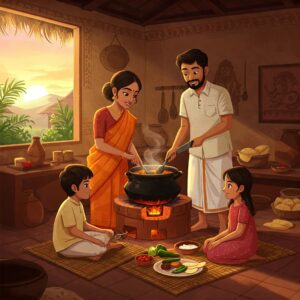
Classic Kerala Kitchen Recipes to Try at Home
These cornerstone recipes showcase the essential techniques and flavors of Kerala cuisine:
1. Kerala Fish Curry (Meen Curry)
This signature dish perfectly exemplifies the balance of heat, tanginess, and creaminess in Kerala cuisine.
Key ingredients:
- Firm white fish (kingfish, pomfret, or tilapia)
- Kudampuli (Malabar tamarind)
- Red chili powder
- Turmeric
- Coconut milk
- Curry leaves
- Mustard seeds for tempering
The distinctive step in authentic preparation is allowing the curry to rest in a clay pot for several hours after cooking, which develops deeper flavor as the spices meld.
2. Kerala Chicken Stew
A mild, fragrant dish often served with appam (rice hoppers).
Key ingredients:
- Chicken pieces with bone
- Thinly sliced onions
- Green chilies
- Whole spices (cardamom, cinnamon, cloves)
- Thick coconut milk
- Black pepper
The technique of sautéing whole spices in coconut oil before adding other ingredients creates a fragrant foundation without overwhelming heat.
3. Avial (Mixed Vegetable Curry)
A quintessential vegetarian dish from Kerala’s Sadya (feast) tradition.
Key ingredients:
- Assorted vegetables cut in uniform lengths
- Yogurt
- Coconut paste
- Curry leaves
- Coconut oil
- Cumin seeds
The defining characteristic is minimal spicing, allowing the natural flavors of the vegetables to shine through the coconut-yogurt sauce.
4. Parippu (Kerala Dal Curry)
This simple yet flavorful preparation of toor dal forms the start of most traditional Kerala meals.
Key ingredients:
- Toor dal (yellow pigeon peas)
- Turmeric
- Green chilies
- Coconut milk
- Curry leaves
- Mustard seed and dried red chili tempering
The authentic preparation involves pressure cooking the dal first, then finishing with coconut milk that’s added only after removing from heat to prevent curdling.
Discover the Magic of Authentic Spices! 🌶️🌿
→ Transform your cooking with the vibrant flavors of Kerala! Our recommended spice collections and specialty ingredients bring restaurant-quality South Indian cuisine to your home kitchen. Click through to explore these authentic products and start your culinary journey today! 👩🍳🛒

The Health Benefits of Kerala Kitchen
Kerala’s cuisine offers significant nutritional advantages, which partly explains why the state has India’s highest life expectancy:
Anti-Inflammatory Properties
The liberal use of turmeric, containing curcumin, provides powerful anti-inflammatory benefits. Research from the National Institutes of Health confirms curcumin’s potential in preventing chronic diseases .
Heart-Healthy Profiles
Despite the use of coconut oil (high in saturated fat), Kerala has lower rates of cardiovascular disease than many regions. Some researchers attribute this to the specific type of medium-chain fatty acids in coconut oil, combined with the abundance of fresh vegetables, fish, and spices in the diet.
Digestive Health
Many Kerala kitchen staples support digestive wellness:
- Curry leaves aid digestion and may help regulate blood sugar
- Black pepper increases the bioavailability of nutrients
- Ginger and asafoetida calm digestive distress
- Fermented foods like appam provide probiotic benefits
Cancer-Fighting Potential
Many spices in Kerala cuisine, particularly black pepper, turmeric, and ginger, contain compounds being studied for their anti-cancer properties. The synergistic effect of these ingredients may contribute to Kerala’s lower cancer rates compared to Western populations.
Kerala Kitchen for Special Diets
The versatility of Kerala cuisine makes it adaptable for various dietary needs:
Vegetarian & Vegan Options
Kerala’s Hindu traditions have created an extensive repertoire of plant-based dishes:
- Olan (white gourd and cowpeas in coconut milk)
- Thoran (stir-fried vegetables with coconut)
- Kalan (yogurt-based curry with plantain and yam)
For vegans, yogurt can be substituted with coconut cream in many traditional recipes without significantly altering the flavor profile.
Gluten-Free Naturally
Most Kerala cuisine is naturally gluten-free, relying on rice, coconut, and lentils rather than wheat:
- Rice flour appams and pathiris
- Cassava and tapioca preparations
- Rice-based desserts and snacks
Low-Carb Adaptations
For those limiting carbohydrates, Kerala cuisine offers options:
- Fish molee (fish in coconut sauce) without rice
- Egg roast with cauliflower rice instead of appam
- Vegetables thoran with increased coconut
Kerala Kitchen Celebration Traditions
Food plays a central role in Kerala’s cultural celebrations:
Onam Sadya
The grand vegetarian feast served during Onam (harvest festival) features over 20 dishes served on banana leaves in a specific arrangement. Each component balances flavors and textures, creating a comprehensive culinary experience that’s greater than the sum of its parts.
Christian Feast Traditions
Kerala’s Syrian Christian community has distinctive feast preparations:
- Duck mappas (roasted duck in spiced coconut sauce)
- Beef ularthiyathu (slow-cooked beef with coconut pieces)
- Meen pollichathu (fish wrapped and baked in banana leaves)
Muslim Celebratory Dishes
Influenced by Arab traders, Kerala Muslims have unique festival foods:
- Thalassery biryani (using local kaima rice)
- Aleesa (wheat and meat porridge)
- Mutta mala (egg garlands) and other intricate sweets
Bringing Kerala Kitchen to Your Dinner Table
Ready to start your Kerala kitchen journey? Here’s a simple weekly plan:
Weekday Kerala Menu
- Monday: Simple dal curry with rice
- Tuesday: Vegetable thoran with chapatis
- Wednesday: Basic fish curry with rice
- Thursday: Egg roast with appam
- Friday: Kerala chicken curry with parotta
Weekend Kerala Feast
When you have more time, attempt a mini-Sadya with:
- Parippu (dal curry)
- Sambar (vegetable and lentil stew)
- Avial (mixed vegetables)
- Thoran (stir-fried vegetables)
- Rice
- Pappadam (crisp lentil wafers)
- Payasam (sweet pudding) for dessert
Entertaining Kerala-Style
Impress guests with a Kerala-inspired dinner party featuring:
- Welcome drinks of spiced buttermilk or kokum juice
- Appetizers of banana chips and savory cutlets
- Main course of fish molee, vegetable thoran, and matta rice
- Dessert of tender coconut pudding
Conclusion: The Timeless Appeal of Kerala Kitchen
The Kerala kitchen represents more than just cooking techniques or flavor profiles—it embodies a philosophy of balance, sustainability, and mindful eating that predates these modern concepts by centuries. By incorporating elements of this culinary tradition into your cooking, you’re connecting with practices refined over generations to promote both pleasure and wellbeing.
What makes Kerala cuisine particularly valuable in today’s fast-paced world is its emphasis on fresh ingredients, balanced nutrition, and the mindful preparation of food. The act of grinding spices by hand or slowly simmering a curry becomes a form of culinary meditation—a counterpoint to the rushed meals that characterize much of modern American life.
As global interest in regional Indian cuisines continues to grow beyond the familiar North Indian restaurant standards, Kerala’s distinctive flavors offer a refreshing new palette for adventurous home cooks. The cuisine’s natural emphasis on gluten-free, plant-forward dishes with moderate spicing makes it accessible even to those new to Indian cooking.
By investing in a few key tools and ingredients, you can transform your kitchen into a space where the fragrant traditions of Kerala come alive—creating meals that nourish both body and spirit with their complexity, balance, and depth of flavor.
Experience Authentic Kerala Cooking Today! 🌴🍳
→ Don’t wait to discover the incredible flavors of Kerala cuisine! The specialized tools and ingredients mentioned throughout this article will transform your home cooking experience. Click on any recommended product to begin your journey into the aromatic world of authentic South Indian cooking. Your taste buds will thank you! 🛍️✨

More FAQ
❓ What makes a Kerala kitchen unique?
✅ A Kerala kitchen stands out for its traditional wood cabinetry, earthy tones, and use of natural materials like clay, brass, and coconut-based cooking tools…
❓ What are essential ingredients in a Kerala kitchen?
✅ A Kerala kitchen often includes coconut oil, curry leaves, mustard seeds, tamarind, and a variety of spices like turmeric and coriander for authentic flavors…
❓ How can I design a Kerala kitchen at home?
✅ To design a Kerala kitchen, incorporate wooden cabinets, traditional cookware, tiled backsplash, and prioritize ventilation for handling spice-rich cooking…
❓ Is a Kerala kitchen suitable for modern homes?
✅ Yes, a Kerala kitchen blends tradition with modernity by integrating classic aesthetics with contemporary appliances and efficient storage solutions…
❓ What cookware is commonly used in a Kerala kitchen?
✅ Common cookware in a Kerala kitchen includes clay pots, bronze urulis, cast iron pans, and traditional coconut graters for authentic food preparation…
Recommended for You:
- 7 Authentic Kakatiya Kitchen Treasures That Will Transform Your Indian Dining Experience
- 7 Authentic India Kitchen Tustin Dishes That Will Transform Your Culinary Experience
- Lolas Kitchen: 10 Mouthwatering Secrets Behind America’s Favorite Hidden Gem
Disclaimer: This article contains affiliate links. If you purchase products through these links, we may earn a small commission at no additional cost to you.
✨ Found this helpful? Share it with your friends! 💬🤗



